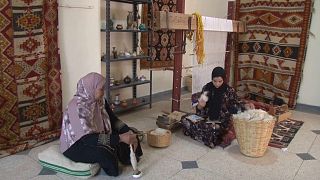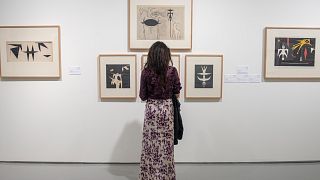Morocco
These two women are among a minority who still have Berber tattoos.
Fatima Masoudi, 89, and Ighoudane Taguelmane, 86, live in Khemissat, a Berber town in Morocco.
Masoudi always wanted to get tattooed, especially because it was a common thing to do when she was young.
"One day when we were moved to the city, I decided to do it. I was 14 years old, I asked my mother to do it but she refused," says Masoudi.
"At that moment, despite her refusal I decided to do it, I went to a woman tattooer, I did it so that I would be beautiful, but unfortunately my mother and my grandmother did not accept this gesture."
In spite of her family's disapproval, Masoudi got tattooed several times, on her chin, neck, and arm.
She chose different patterns that are symbols of the Berber culture.
Taguelmane had an opposite experience with tattoos: she was forced by her mother to get one at a young age.
She was tattooed between her eyes and on her chin.
At that time, tattoo centres were considered like beauty salons -- a place where women used to go to look pretty.
But the process was painful.
''There were several tattoo patterns and each one chose what they wanted, they used black charcoal, then stitching the skin with a needle and placing the substance through these openings and wounds to remain inside of the skin,'' says Taguelmane.
''This operation was very painful, then I waited for a week until there was a crust on my face, then I removed it, at this time we can see the final result of the tattoo."
Tattooers also use saltwater and herbs for sterilization.
Historically, the origins of such tattoos are hard to pinpoint.
"There is no exact date, but what is known is that the Berber tribes, since the ancient drawings that were found in the caves, and based on some books and sources that talked about tattoos in the Berber tribes, it dates back to thousands of years," says Mohamed Es-Semmar, a historian.
Berbers used to live in several Berber regions of North Africa, and they often lived in the mountainous and desert areas.
Most of the symbols used in tattoos are inspired by nature.
"Amazigh use many symbols, in various types of carpets, ornaments for women, as well as in tattoos,'' says Es-Semmar.
''Symbols were numerous, such as triangles and half circles. We find these in earrings, bracelets, anklets. We also find these symbols in many Amazigh dresses and costumes, whether for women or men. And also we find several symbols in the home utensils, and we can't forget as well the architecture, for example, wood, gypsum, and also stone engraving, always the same symbols that they used in tattoos."
The symbols can, among others, have meanings related to strength, energy, fertility, healing, and protection from envy.
Berber tattoos were used to determine tribal affiliation and identity, indicate the marital status of women as well as if they were ready for marriage.
They were also done for cosmetic and therapeutic reasons.
"The Berber tattoo was totally different from what we see today, it had several meanings and several patterns, each one has its own definition, but today this modern tattoo we see, is not mine, it comes from other countries and young people prefer it and do it too," says Masoudi.
Tattoos were not limited to women, but men's were much smaller and discreet.
Nowadays, if Berber tattoos are hard to find, it's because of a larger phenomenon.
"Tattoos have largely disappeared among the Berber tribes due to the fact that the Berber tribes have disappeared. Is there still a tribe? The Berber society has changed," says Es-Semmar.
Others also tend to get the tattoos removed for religious reasons.
"When I did the tattoo, I did not know that it is forbidden in Islam, when I went to the pilgrimage, I asked about that and they told me that there is no problem, because when I did it I did not know anything, but despite that I'm afraid and I want to remove it," says Taguelmane.
The tattoos have started to disappear since the 1960s, and with them, a part of the Berber culture.













Go to video
Angélique Kidjo makes history as first black African artist on Hollywood Walk of Fame
02:18
Netherlands returns 119 artifacts looted from Nigeria
02:20
"Autophagies": so much more than a culinary performance
02:19
Australia’s new African heritage Hub builds culture and community
Go to video
Allen Payne, Eva Marcille bring cult classic 'Jason's Lyric' film to the stage
Go to video
The second edition of Abidjan Art Week comes to a close